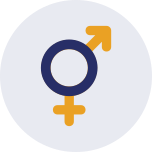IASC Gender Accountability Framework Report 2021
 The 2021 IASC Gender Accountability Framework Report is a product of the Inter-Agency Standing Committee’s (IASC) Reference Group for Gender in Humanitarian Action (GRG) developed by UN Women in its role as the GRG’s Gender Desk.
The 2021 IASC Gender Accountability Framework Report is a product of the Inter-Agency Standing Committee’s (IASC) Reference Group for Gender in Humanitarian Action (GRG) developed by UN Women in its role as the GRG’s Gender Desk.
Executive summary
The 2021 Inter-Agency Standing Committee (IASC) Gender Accountability Framework (GAF) report marks the fourth monitoring cycle of the IASC’s 2017 Gender Equality and the Empowerment of Women and Girls in Humanitarian Action Policy. It provides a snapshot of the IASC’s output in the calendar year 2021 and allows for cross comparison with the baseline established with the 2018 GAF report and the subsequent 2019 and 2020 reports.
In 2021, the application of the Gender Policy at the global level showed mixed results but overall progress. Gender integrated outputs of IASC Principals increased from 77 percent in 2020 to 80 percent in 2021. There was a significant reduction in the overall number of outputs in 2021 compared to 2020 which can be attributed to the large number of guidance materials issued specifically in response to the pandemic (i.e., in 2020 there were 22 outputs by the IASC Principals compared with just five outputs in 2021). There was also an improvement in the percentage of Operational Policy and Advocacy Group (OPAG) Results Groups complying with the IASC Gender Policy at 40 percent, up from 20 percent for both 2019 and 2020, but still well below desired benchmarks. Results Groups’ meaningful references to gender equality and the empowerment of women and girls also increased (from 20 percent in 2019 to 40 percent in 20211 ).
Despite improvements at the global level, there was uneven support from the global structure of the IASC to its field representation in implementing the IASC’s Gender Policy. However, many more global clusters nominated a Gender Focal Point (from 33 percent of clusters in 2019 to 75 percent of clusters in 20212 ). All clusters, apart from the Emergency Telecommunications Cluster, reported having a Gender Focal Point in 2021.
Implementation of the Gender Policy at the field level continues to improve in 2021 vis-à-vis Humanitarian Needs Overviews (HNOs) and Humanitarian Response Plans (HRPs). The use of sex and age disaggregated data (SADD) and gender analysis was demonstrated in 85 percent of HNOs, compared to 2020 where it was just over half. There was a notable increase in the number of HRPs that included provisions for women’s economic empowerment (from 63 percent the previous year to 95 percent). Although there was minor improvement in provisions for sexual and reproductive health that went beyond maternal and child health (MCH) (from 92 percent the previous year to 95 percent), out of the HRPs reviewed, all 21 contained provisions to mitigate and respond to gender-based violence.
Despite gradual improvements in recent years of crisis contexts consulting women’s rights organizations, this year that rate dropped marginally from 68 percent to 65 percent. The percentage of countries with Humanitarian Coordinators (HCs) that have a functioning Gender Reference/Working Group shrank from 81 percent in 2020 to 62 percent in 2021. In two contexts, country responses indicated that while such a group was previously activated, it was not functioning in 2021, showing a backsliding in gender work in the field.
An increase in the percentage of Humanitarian Country Teams (HCTs) with sustained gender capacity in IASC managed country contexts is noteworthy but remains just below half at 45 percent. There were also minimal improvements in the percentage of HCTs which have prepared and implemented a plan on gender equality and the empowerment of women and girls, including strategies for engagement with local women’s organizations. Though it is still low at just 22 percent.
There was a major reduction in the proportion of joint gender analyses in 2021 from the year before. This is likely mostly attributable to the high number of joint gender analysis conducted in 2020 specifically on the impact of COVID-19. While the rate of joint gender analysis in 2021 is much lower than in 2020 (39 percent versus 75 percent respectively), it is still an improvement from the year before (25 percent in 2019).
